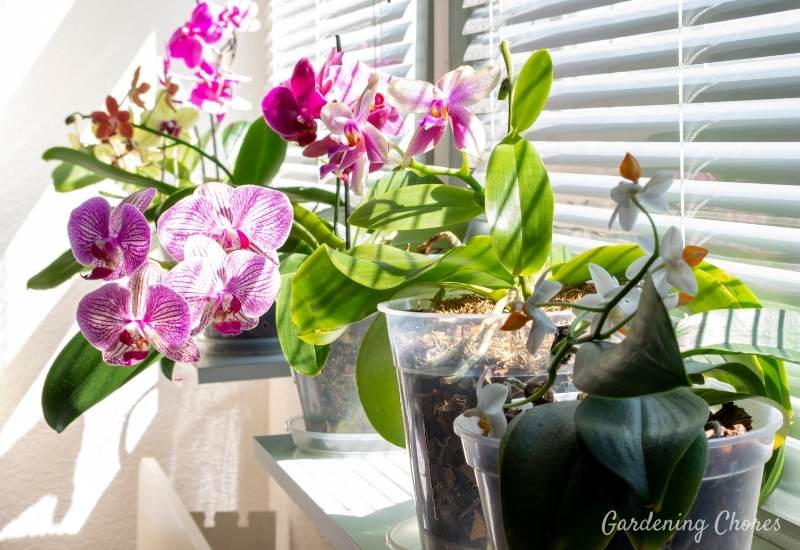
Orchids are a well-known favorite as a beautiful and elegant addition to the home. In general, they will not do well with direct sunlight, however amount of light required for an orchid to bloom will vary based on the genus. So, how to tell if your orchids are getting enough light?
With over 25,000 known species of orchids on the planet, there are many different varieties which are commonly grown as houseplants. The most common variety of orchid kept at home is the Phalaenopsis orchid (also known as the moth orchid), which has lower light requirements than most other species.
While there are many factors which play key roles in triggering an orchid to bloom, none of these will be successful unless the orchids specific light requirements are met.
In this article, we will discuss exactly how much light orchids require to bloom, how to identify any problems with light, and how to fix them.
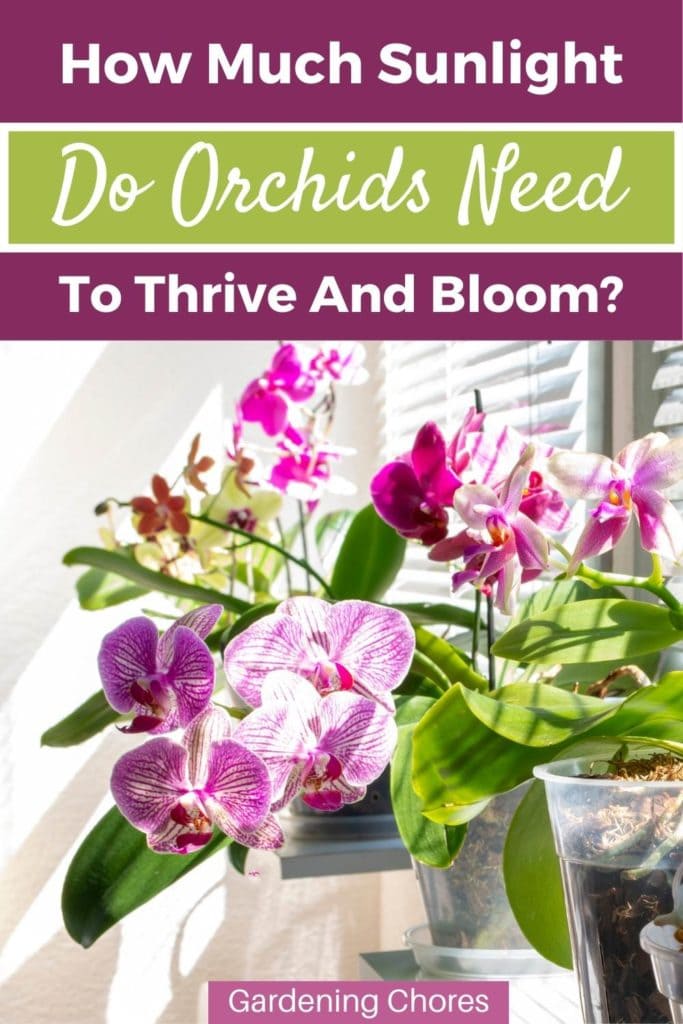
So, How Much Sunlight Do Most Orchids Need?
Orchids thrive with 6 to 8 hours of bright, indirect sunlight per day. They will do best if placed in an east or west facing window, depending on the variety of orchid, where the sunlight is not too intense or direct. Grow lights can be very helpful for providing consistent light conditions, without the damaging heat of direct sunlight.
Native to forests on every continent except for Antartica, orchids are most commonly found in the tropical regions of Asia, Central and South America.
Most orchid species are epiphytes (air-growing). This means that instead of growing on the forest floor, they would typically be found growing in the lower canopy using another plant species (usually a tree branch or stump) as a host.
Clinging to their host plant, orchids draw their moisture and nutrients from humidity in the air, rain, and decomposing particulate matter which may fall around them.
Since orchids have adapted to life below the forest canopy, they are not used to receiving very much, if any, direct sunlight.
The Best Place To Put An Orchid To Make Sure Your Orchids Get Enough Light
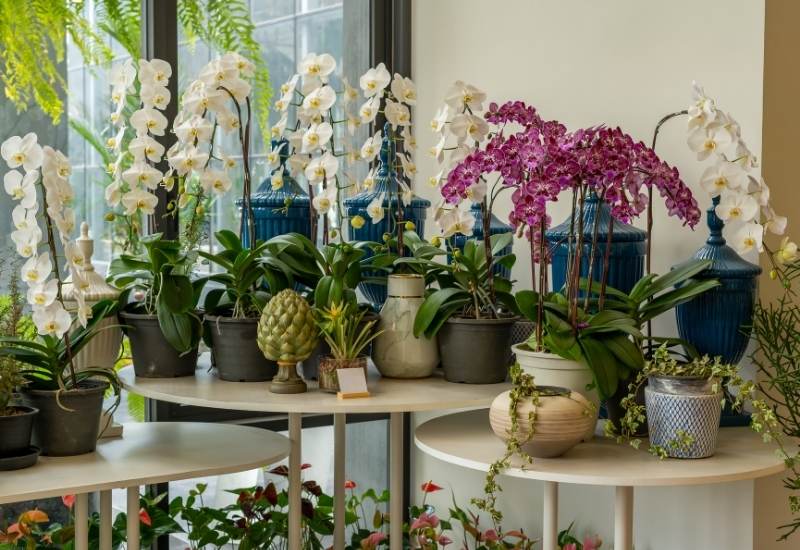
The ideal placement for an orchid in your home would be in front of an east or west facing window, depending on the type of orchid. We will discuss specific light requirements for individual orchid types later on in the article.
Since light conditions will vary dramatically based on the distance from a window, sometimes a simple move from the windowsill to a nearby side table can be the solution to light issues.
For plants who are sensitive to sunlight like orchids, it can take some patience and fine-tuning to provide ideal light conditions.
Unfortunately, placing an orchid across the room from a window, or in a room which faces north, is unlikely to provide sufficient sunlight.
Depending on the genus, most orchids will suffer with anything more than 1-2 hours of direct sunlight per day.
A few of the more light-tolerant orchids like the Vanda, Cattleya, or Dendrobium, are capable of being acclimated to some direct sunlight, as long as the foliage does not get too hot.
If your window receives too much direct sunlight, another option is to aim for filtered light. This can be achieved by placing the orchid in front of a window which has a sheer curtain or some blinds.
determine Types Of Light You Have In Your Home
When it comes to sunlight for orchids, there are three important factors to focus on: intensity, duration, and quality.
The intensity of light your orchid receives will depend on its proximity to a window, and the direction of which the window faces. Light from east facing windows is ideal for orchids, because the morning sun is less intense.
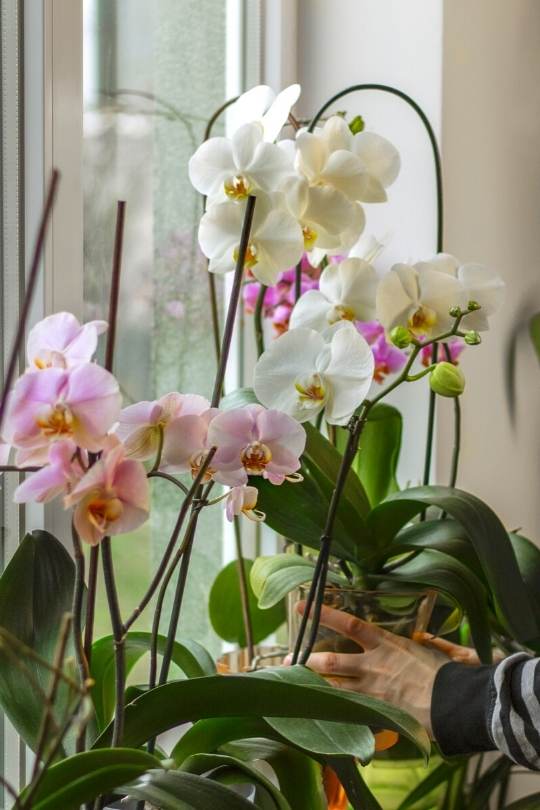
The sun is at its most intense during the middle of the day when it is highest in the sky. This is why direct sunlight from a south facing window is likely to burn the foliage of your orchid.
Duration will also depend on the direction of which the window faces. East and west facing windows will only receive direct sunlight for a few hours in the morning or late afternoon, respectively. However, the sunlight from a west facing window will be slightly more intense.
Finally, quality of light is especially important when growing orchids. In order for them to flower, they will require light from both the red and blue ends of the spectrum.
Make sure your plant is close to the window, and that the window is clean and free of obstructions. Dirty, stained glass, or tinted windows will filter out much of the light spectrum used by plants for growth and flowering.
3 Easy Ways to Check If Your Orchids Are Getting Enough Light
How much sunlight your orchid is getting is crucial for it to flourish and bloom year after year, and here are three way to determine.
1: Observe the Leaves
The easiest way to monitor light conditions for your orchid is to observe their response to the light by checking their leaves.
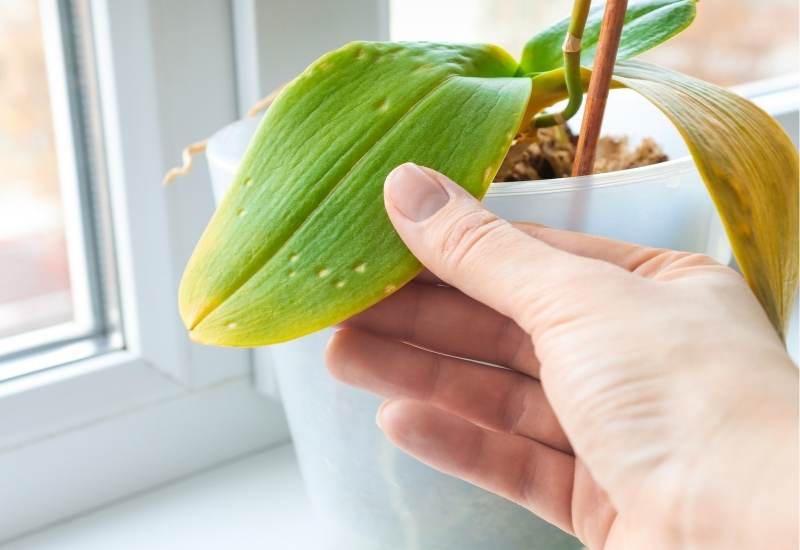
Pale green leaves which begin to take on a more yellow appearance are a sign of excessive light.
This will be followed by reddish spots and browned tips. If this happens, it is important to move your orchid to lower light conditions before the damage becomes too severe.
On the other hand, if the leaves are a darker green colour, similar to a lush green lawn, this is a sign that your orchid is not receiving enough sunlight. It can tolerate these conditions, but it will struggle to bloom and will not thrive.
2: Find Out With A Shadow Test
A more proactive approach is to test the amount of shadow which is cast on the leaves of your orchid.
On a clear day, position your hand between the plant and its light source. Holding your hand about a foot from the plant, observe the shadow it casts over the leaves.
If there is no shadow, then your orchid is not receiving bright enough sunlight. If the shadow is blurred and faint, your light level is probably sufficient for most orchids.
A sharp and well-defined shadow will be better suited for the higher light-tolerant orchids mentioned earlier.
3: Use a Light Meter
Alternatively, you can purchase a light meter like this one to accurately measure the intensity of light that your plant is receiving.
Light is usually measured using foot candles, or lux. Technically, a foot candle (fc) describes the amount of light one candle would emit from 1 foot away, while lux is the basic metric system unit of illumination.
Either of these measurements will work and there are many online calculators you can use to do the conversions if needed.
Light Requirements For Low, Medium And High Light Orchids
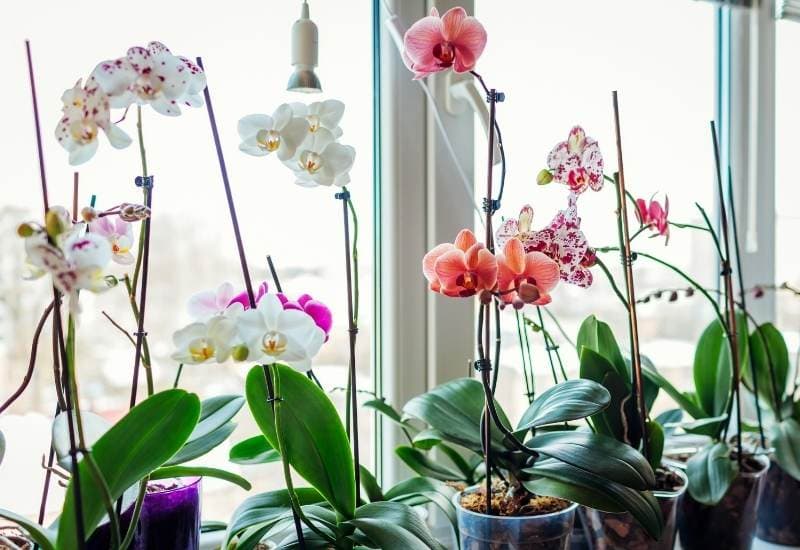
While a orchid may tolerate lower light growing conditions, but Insufficient light is the most common cause of failure to re-bloom your orchid.
However, the amount of light will depends on types of orchid you have. Some low-light orchid species like Phalaenopsis can survive in low light and while high-light orchids like Brassavolas love very bright light or direct sunlight filtered.
Here are types of low, medium and high light orchids and how much light that certain orchids need to flourish indoors.
1: Low-light Orchids
Low-light orchids are the most sensitive to direct sunlight. They will do best in an east facing windowsill, in a west window with a shear curtain, or a few feet away from a window with some direct sunlight.
Low light orchids prefer conditions which would cast a faint, blurry shadow, if doing the shadow test. Ideally their location would measure around 1000 – 2000 foot candles, or 10700 – 21000 lux. Here are examples of orchids that can do well in low light conditions:
2: Mid-light Orchids
These orchids prefer light in the mid-range of intensity, still avoiding exposure to intense direct sunlight. They would do best in an east facing windowsill, a west facing windowsill, or a few feet away from a window with some direct sunlight
They would still prefer conditions which cast a faint, blurry shadow on the leaves with the shadow test. Their ideal light measurements would generally be around 2000 – 3000 foot candles, or 21000 – 32000 lux. Some examples of mid-light orchids are:
3: Higher-light Orchids
There are a few orchids how can be acclimated to higher light conditions, however direct sunlight which is intense for extended periods of time would still be an issue.
These orchids will do best if placed in a west facing windowsill, or possibly in a south-facing window which has a shear curtain.
They prefer conditions which would cast a slightly more well defined shadow over the leaves, than the other orchids mentioned above. These conditions should measure around 2000 – 5000 foot candles, or 21000 – 53000 lux. Some examples of higher-light orchids are:
The Dendrobiumn orchid has been mentioned twice here, because it is a highly versatile orchid. It can thrive in a wider range of light conditions than most, from 1500 – 5000 foot candles, or 16000 – 53000 lux.
If a plant is not receiving enough light or too much much direct sunlight there are tell tale signs to look out for. Here are the common problems caused by incorrect lighting.
To Tell If Your Orchid Is Getting Excessive Sunlight?
If your orchid is getting too much light, it will let you know. However in the early stages, it can be easy to confuse with being beneficial. Increased sunlight may initially lead to more prolific blooming and even reblooming from the same flower spike.
Unfortunately, the initial benefits of increased sunlight will quickly be replaced with irreparable damage to the leaves.
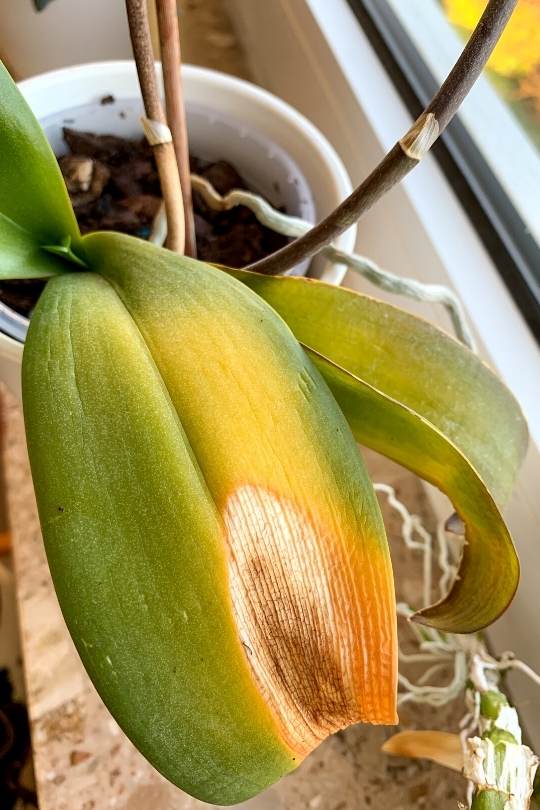
With excessive sunlight, the leaves of your orchids will become a pale green colors, closer to yellow, as they begin to burn. This will be followed by reddish spots around the edges of the leaves, progressing further to brown patches and tips if nothing is done.
In these conditions, the leaves will also become wrinkled and deformed due to low humidity.
It is important to move your orchid to a location with less direct sunlight as soon as you notice the leaves are beginning to change color. Once the browning begins to appear, the damage can quickly become quite significant.
Issues With Insufficient Sunlight For Orchids
Insufficient sunlight can be harder to identify with orchids. This is because the leaves will often appear to be a lush and vibrant green colour.
The orchid leaves will actually become darker with insufficient light, as they try to hold onto more chlorophyll to aid in photosynthesis with the limited light available. Even though the leaves may be an attractive dark green, this is actually a sign that your orchid is starting to struggle.
In lower light conditions, it is highly unlikely that your orchid will be able to produce new blooms.
However, use caution when moving an orchid from low light to higher light conditions. As with most houseplants, suddenly moving them from one extreme environment to another can shock the plant and stunt its growth or cause damage.
Its better to take this process slowly, moving from darker conditions to a few days in moderate light, before moving to its final resting place in what you have identified as the perfect location.
Use Grow Lights When To Make Up For The Lack Of Natural Sunlight
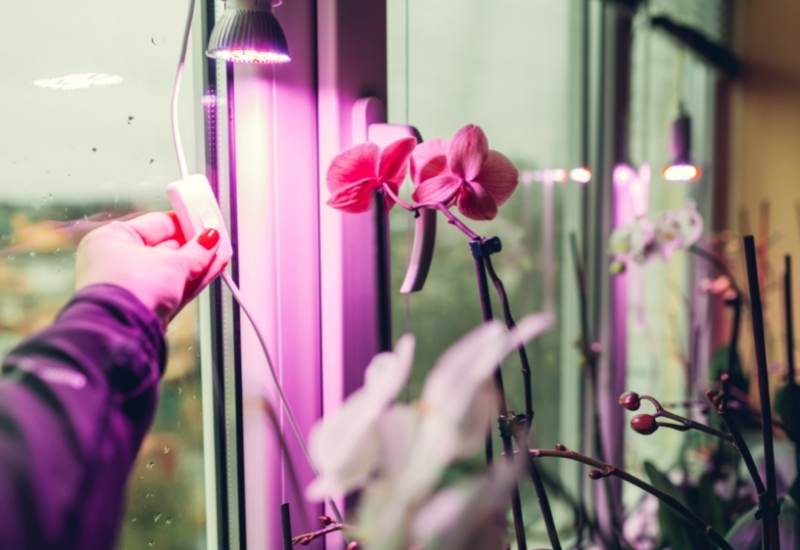
For optimal control of light conditions, LED grow lights like this one can be used for growing orchids. Remember that more light is not always better, and orchids need night time, just as much as they need the day.
Most grow lights come with a built in timer system which allows you to set your lights to turn on and off automatically, creating a perfect lighting schedule. If a timer does not come included, you can buy separate plug in timer like this one
Proper Light Exposure Is The Key To Successful Blooming Orchids
The most important factor for healthy orchids with beautiful, long-lasting blooms is sunlight. Selecting the right location for your orchid might take a few tries, as you fine-tune the light conditions.
Choosing the perfect spot for you orchid to call home is essential in allowing it to thrive. When provided with bright, indirect sunlight from an east or west facing window, orchids can make a wonderful and eye-catching, yet low-maintenance houseplant.

Written By
Amber Noyes
Amber Noyes was born and raised in a suburban California town, San Mateo. She holds a master’s degree in horticulture from the University of California as well as a BS in Biology from the University of San Francisco. With experience working on an organic farm, water conservation research, farmers’ markets, and plant nursery, she understands what makes plants thrive and how we can better understand the connection between microclimate and plant health. When she’s not on the land, Amber loves informing people of new ideas/things related to gardening, especially organic gardening, houseplants, and growing plants in a small space.
